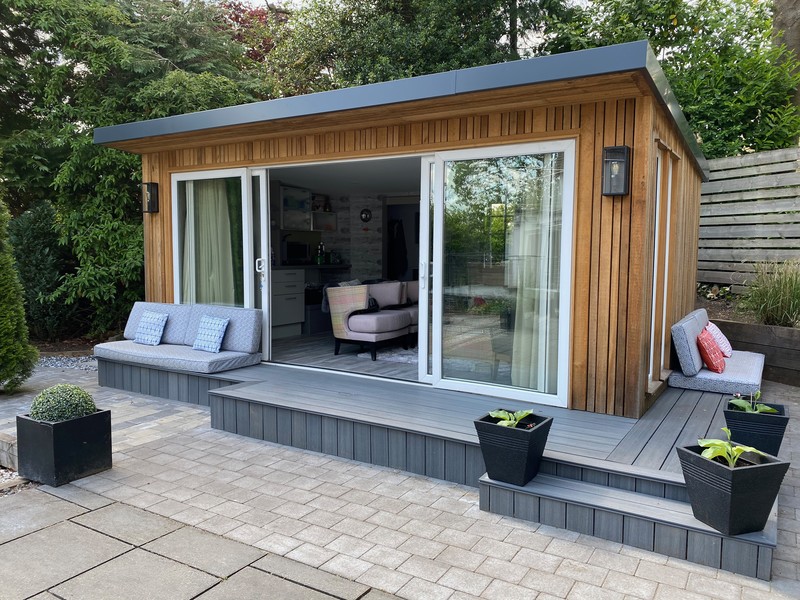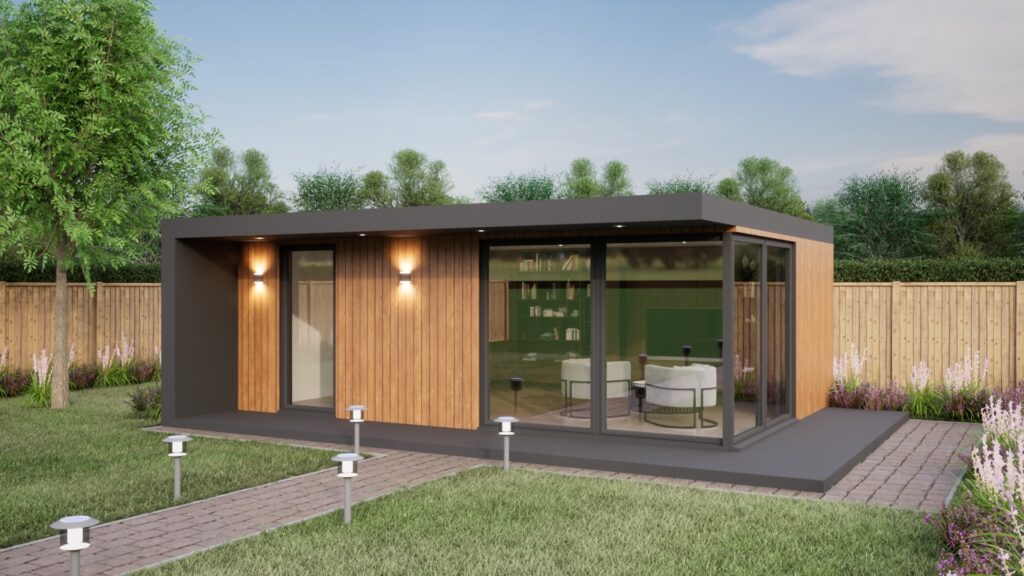Certain restrictions are required when building conservatories or garden rooms, outhouses or garden offices in conservation zones. These restrictions are designed to preserve the look and feel of these designated areas. Planning permits are required for conservation areas. Here are some key considerations.
Any building or extension that would otherwise fall under allowed development rights might require planning permission within a conservation area. This is the case for garden sheds as well as other outbuildings.
Size and Scale
Planning permission may be required for any structure, regardless of size if it affects the nature of a conservation area. Extensions and new buildings in designated zones are subject to more stringent rules.
The location within the property:
Planning permission is usually needed for extensions and constructions that are located on the front or sides of the property. Rear structures might also require permission if they are visible from public areas or if they affect the style of the neighborhood.
Materials and Design
Design and materials are essential in conservation zones. The construction or extension should use materials that are in keeping with the historic or architectural interest of the region. This will require the issuance of a planning permit. granted.
Demolition:
In conservation areas, it is necessary to get planning permission prior to the demolition of any construction or part of a building, including outbuildings or wall boundaries. This is in order to ensure that all changes do not alter the nature of the area.
Height Restrictions
In conservation areas there are higher height restrictions in conservation areas. Anything that is over 2.5 meters high (especially within two metres of the boundary line) will probably require approval for planning.
Effects on the Surroundings
Planning permission is required when the proposed extension or building is likely to impact the visual appearance or setting of the Conservation Area as well as the views that pass through and exit the Conservation Area.
The building is used to:
Planning permission may be required even if the garden or outbuilding is within permitted dimensions. This could be due to a change in use of the property.
The following are extensions and modifications:
Planning permission is typically required for extensions which exceed the specified size or volume limits or that alter the exterior appearance. This is the case for conservatories and other major changes.
Curtilage Structures:
The curtilage surrounding the listed building within conservation zones always requires planning permission. This is applicable to all new extensions or alterations and also new outbuildings.
The Trees are protected
Conservation zones have trees that are usually protected. Tree works consent may be required if you plan a project which will impact trees.
Local Authority Guidelines
Every conservation area can have specific guidelines and restrictions that are set by the local authority for planning. These can include detailed criteria about what is permissible and what isn't specific to the particular nature of the region.
Planning permission is required for conservation areas. This involves a thorough assessment of the impact that the extension such as a garden room, an outhouse, conservatory or garden office could have on the historic and architectural characteristics of the area. Consulting with your local planning authority early in the process of planning is crucial to ensure that your plan conforms to all relevant laws and guidelines. Take a look at the top rated what is a conservatory room for site info including do you need planning permission for a garden room, my outhouse, composite summer house, do i need planning permission for a garden room with toilet, garden rooms brookmans park, costco garden room, how to get power to a garden room, garden rooms, outhouse for garden, garden room permitted development and more.

What Kind Of Planning Permission Is Needed For Gardens, Rooms Etc. With Regard To The Impact On The Environment?
Planning permissions can be subject to the environmental impacts of garden rooms, conservatories and outhouses. Here are key environmental considerations Biodiversity
Planning permission is required in the event that a proposed structure impacts local habitats for wildlife (such as hedgerows, trees, or ponds). A study of the ecological impact might be necessary to evaluate and mitigate the impacts on biodiversity.
Habitats and species protected
The site must be approved for development if it has or is located near protected species (e.g. Bats, Newts) or habitats that are that are protected (e.g. Sites of Special Scientific Interest SSSI). To protect them it is essential to take particular measures.
Preservation Orders for Trees Preservation Orders
Planning permission might be required when the construction involves the removal or alteration of trees covered under TPOs. The local authority can ask for replacement plantings or alternative mitigation measures.
Flood Risk and Water Management
Planning permission is required to build near the shoreline or in flood-prone areas. A flood risk assessment (FRA) might be necessary to ensure that the structure does not create more flood risk and also has drainage solutions that are adequate.
Sustainable Construction Practices
You may need permission for planning to ensure that the construction and materials are sustainable. This includes considerations for energy efficiency, insulation, and the carbon footprint of building materials.
Drainage of Surface Water Runoff
Environmental concerns include the effect of a new building on surface water runoff and drainage. Planning permission ensures that proper drainage systems are in place to stop waterlogging or flooding.
Stability of soil and soil
Planning permission will be necessary if the construction is expected to impact soil stability or soil quality. This can include issues such as erosion or subsidence of the soil, particularly on sloped land.
Air Quality
For developments that may impact local air quality for example, those located near major roads or industrial zones, planning permission is needed. The air pollution level must be within acceptable levels and mitigation measures should be implemented.
Noise Pollution:
The planning permission is required when you plan to utilize the garden extension or the room in a manner that could generate significant sound (e.g. an instrument or workshop studio). The local authority must evaluate the noise level and any potential impact on neighbours and the environment.
Waste Management:
The proper disposal of waste throughout construction and afterwards is vital. Planning permission guarantees there are recycling plans and waste disposal in order to reduce environmental impact.
Energy Efficiency
Planning permission can be accompanied by the need for energy efficient technology including solar panels, for example. high-performance glass. This helps reduce the environmental footprint of the new structure.
Environmental Regulations
Environmental laws and regulations are applicable to every development which includes the UK Environmental Protection Act. Planning permission is required to ensure that the development is in compliance with all legal and environmental conditions.
Permissions to design conservatories or gardens, as well as outhouses, office buildings and garden offices must consider a variety of environmental factors. In order to ensure that the construction planned is sustainable It is crucial to seek out local planning authorities prior to the planning phase as is possible. Have a look at the best herts garden buildings for more recommendations including garden rooms near me, garden office hertfordshire, small garden office, how to get power to a garden room, costco garden rooms, insulated garden buildings, garden rooms, garden office, gym outhouse, garden room conservatory and more.

What Planning Permissions Are Required For Garden Rooms, Etc. On Agricultural Lands?
If you plan to build an extension, a conservatory, garden office, an outhouse or if you want to expand your property, you will need to get permission to plan. Here are key points to take into consideration: Change of Use
The land classified as agricultural land is typically used for agriculture or other related activities. The conversion of this land to gardens or residential structures generally requires permission for planning. It is essential to get permission to plan because the land's designated agriculture will change.
Permitted Development Rights:
Land for agriculture is typically subject to different permissible development restrictions than residential land. In certain cases agricultural structures can be constructed without planning approval. However, these rights, are only applicable to agricultural structures.
Size and Scale
The size and scale of the proposed structure could determine whether a permit for planning is required. Larger buildings or those which cover a large part of the area are more likely to require planning permission.
Effects of Agricultural Use
Planning permission will likely to be required when the new construction is disruptive to the agricultural uses of the land. This could mean that the land is reduced in available space for livestock and crops.
Green Belt Land:
The restrictions placed on land are intended to restrict the growth of cities and also preserve open space. Typically, any building on Green Belt property requires planning approval and must satisfy the strict requirements.
Design and Appearance
The new structure should be constructed and designed in a way that is compatible with the rural features of the surrounding region. The permission for planning will guarantee that the building won't negatively impact the natural landscape or visual amenities.
Environmental Impact:
The impact on the environment is a factor when building on land that is agricultural. Planning permission might be required to carry out an environmental impact assessment in order to make sure that the construction doesn't damage local ecosystems or wildlife habitats.
Proximity to Existing Buildings:
The requirements for planning may be affected by the proximity of the proposed office or garden space is to existing agricultural structures. Buildings constructed near farms will be treated differently to those situated on open fields.
Access and Infrastructure
It is important to consider the effect of the proposed building on existing infrastructure such as roads, waste management, and water supply. The planning permit will decide whether the existing infrastructure is able to support a new building.
Order by Class:
Planning law specifies the use classes for agricultural land. Planning permission is typically required to change the usage category of a structure to one that is not under the agricultural category.
Local Planning Policy:
Local planning authorities have specific policies for agriculture-related land. Planning permission is granted for non-agricultural structures, according to these guidelines that take into consideration local development plans and community needs.
National Planning Policy Framework
In the UK the National Planning Policy Framework gives guidelines on how to use and develop land. The NPPF can be used to determine the application of planning permissions to structures built on agricultural lands. It promotes sustainable development of rural areas and safeguards them.
Generally, permission to build extensions, gardens, or conservatories on agricultural land is necessary due to the necessity to alter its use, and also to ensure compliance with local and federal planning policies. To find out the exact requirements and to get the necessary approvals, it is essential that you consult the local planning authorities. See the best heating for garden room for site examples including outhouse building, what size garden room without planning permission, garden room vs extension, what size garden room without planning permission uk, garden room planning permission, gym outhouse, armoured cable for garden room, ground screws vs concrete, Tring garden rooms, garden room permitted development and more.
